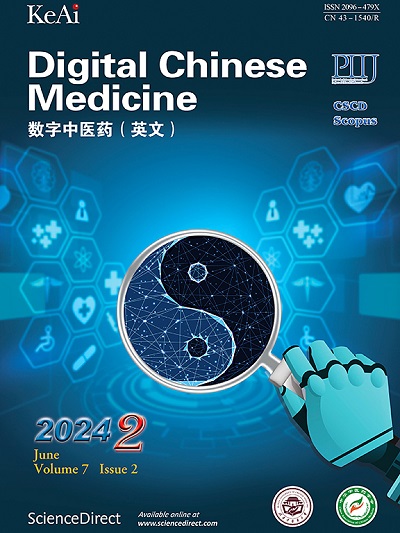一种整合中药材色谱指纹分析单元的新方法:匹配频率统计矩法
Q3 Medicine
引用次数: 0
摘要
目的建立并实施匹配频率统计矩(MFSM)方法,为中药材质量评价提供依据。方法建立MFSM方法。为了证明其有效性,我们应用这种新方法分析了丹西颗粒(,DXG)及其成分。首先,采用超高效液相色谱法(UPLC)获得了DXG及其成分药材的色谱指纹图谱。接下来,利用MFSM压缩并将它们集成到具有更少分析单元的新指纹中。然后,我们通过计算总量子统计矩(TQSM)参数、信息熵和信息量及其相对标准偏差(RSD)来表征原始指纹和集成指纹的性质和变异性。最后,比较了传统指纹和新型指纹的TQSM参数、信息熵和信息量及其RSD,验证了新方法的有效性。结果用MFSM方法对DXG及其12种原料药的色谱峰进行了划分和整合。整合前,DXG及其12种原料药UPLC指纹图谱各峰或峰族的峰数、3个TQSM参数、信息熵和信息量的取值范围为95.07−209.73,< style-type=“number”> 990 </style -content>;−<style -content style-type="number">183064<;μv·s, 5.928−21.33分钟,22.62−106.69分钟2,4.230−6.539,和>; style- content style-type="number">50530</style -content>;−<style -content style-type="number">;分别μv·s。整合后,这些参数的取值范围为10.00 - 88.00,<style -content style-type="number">9390</style -content>;−<style -content style-type="number">183064<;μv·s, 5.951−22.02分钟,22.27−104.73分钟,2.223−5.277,和>; style- content style-type="number">38159</style -content>;−<style -content style-type="number">;分别μv·s。相应的,上述各参数积分前的RSD分别为2.12% ~ 9.15%、6.04% ~ 49.78%、1.15% ~ 23.10%、3.97% ~ 25.79%、1.49% ~ 19.86%、6.64% ~ 51.20%。整合后分别为0.00%、6.04% ~ 49.87%、1.73% ~ 23.02%、3.84% ~ 26.85%、1.17% ~ 16.54%和6.40% ~ 48.59%。结果表明,在新整合的指纹图谱中,药材成分的分析单位、信息熵和信息量均显著降低(P <;0.05), TQSM参数保持不变(P >;0.05)。此外,TQSM参数、信息熵和信息量的RSD在整合前后无显著差异(P >;0.05),但综合分析单元数量和面积的RSD显著降低(P <;0.05)。结论MFSM方法可以减少药材成分的分析单位,同时保持药材的性质和与原始指纹图谱的可变性。因此,它可以作为一种可行和可靠的工具,以减少在三坐标测量机中分析多组分的困难,促进其质量评价。本文章由计算机程序翻译,如有差异,请以英文原文为准。
A novel method for integrating chromatographic fingerprint analytical units of Chinese materia medica: the matching frequency statistical moment method
Objective
To facilitate the quality evaluation suitable for the unique characteristics of Chinese materia medica (CMM) by developing and implementing a novel approach known as the matching frequency statistical moment (MFSM) method.
Methods
This study established the MFSM method. To demonstrate its effectiveness, we applied this novel approach to analyze Danxi Granules (丹膝颗粒, DXG) and its constituent herbal materials. To begin with, the ultra-performance liquid chromatography (UPLC) was applied to obtain the chromatographic fingerprints of DXG and its constituent herbal materials. Next, the MFSM was leveraged to compress and integrate them into a new fingerprint with fewer analytical units. Then, we characterized the properties and variability of both the original and integrated fingerprints by calculating total quantum statistical moment (TQSM) parameters, information entropy and information amount, along with their relative standard deviation (RSD). Finally, we compared the TQSM parameters, information entropy and information amount, and their RSD between the traditional and novel fingerprints to validate the new analytical method.
Results
The chromatographic peaks of DXG and its 12 raw herbal materials were divided and integrated into peak families by the MFSM method. Before integration, the ranges of the peak number, three TQSM parameters, information entropy and information amount for each peak or peak family of UPLC fingerprints of DXG and its 12 raw herbal materials were 95.07 − 209.73, <styled-content style-type="number">9390</styled-content> − <styled-content style-type="number">183064</styled-content> μv·s, 5.928 − 21.33 min, 22.62 − 106.69 min2, 4.230 − 6.539, and <styled-content style-type="number">50530</styled-content> − <styled-content style-type="number">974186</styled-content> μv·s, respectively. After integration, the ranges of these parameters were 10.00 − 88.00, <styled-content style-type="number">9390</styled-content> − <styled-content style-type="number">183064</styled-content> μv·s, 5.951 − 22.02 min, 22.27 − 104.73 min2, 2.223 − 5.277, and <styled-content style-type="number">38159</styled-content> − <styled-content style-type="number">807200</styled-content> μv·s, respectively. Correspondingly, the RSD of all the aforementioned parameters before integration were 2.12% − 9.15%, 6.04% − 49.78%, 1.15% − 23.10%, 3.97% − 25.79%, 1.49% − 19.86%, and 6.64% − 51.20%, respectively. However, after integration, they changed to 0.00%, 6.04% − 49.87%, 1.73% − 23.02%, 3.84% − 26.85%, 1.17% − 16.54%, and 6.40% − 48.59%, respectively. The results demonstrated that in the newly integrated fingerprint, the analytical units of constituent herbal materials, information entropy and information amount were significantly reduced (P < 0.05), while the TQSM parameters remained unchanged (P > 0.05). Additionally, the RSD of the TQSM parameters, information entropy, and information amount didn’t show significant difference before and after integration (P > 0.05), but the RSD of the number and area of the integrated analytical units significantly decreased (P < 0.05).
Conclusion
The MFSM method could reduce the analytical units of constituent herbal materials while maintain the properties and variability from their original fingerprint. Thus, it could serve as a feasible and reliable tool to reduce difficulties in analyzing multi-components within CMMs and facilitating the evaluation of their quality.
求助全文
通过发布文献求助,成功后即可免费获取论文全文。
去求助
来源期刊

Digital Chinese Medicine
Medicine-Complementary and Alternative Medicine
CiteScore
1.80
自引率
0.00%
发文量
126
审稿时长
63 days
期刊介绍:
 求助内容:
求助内容: 应助结果提醒方式:
应助结果提醒方式:


